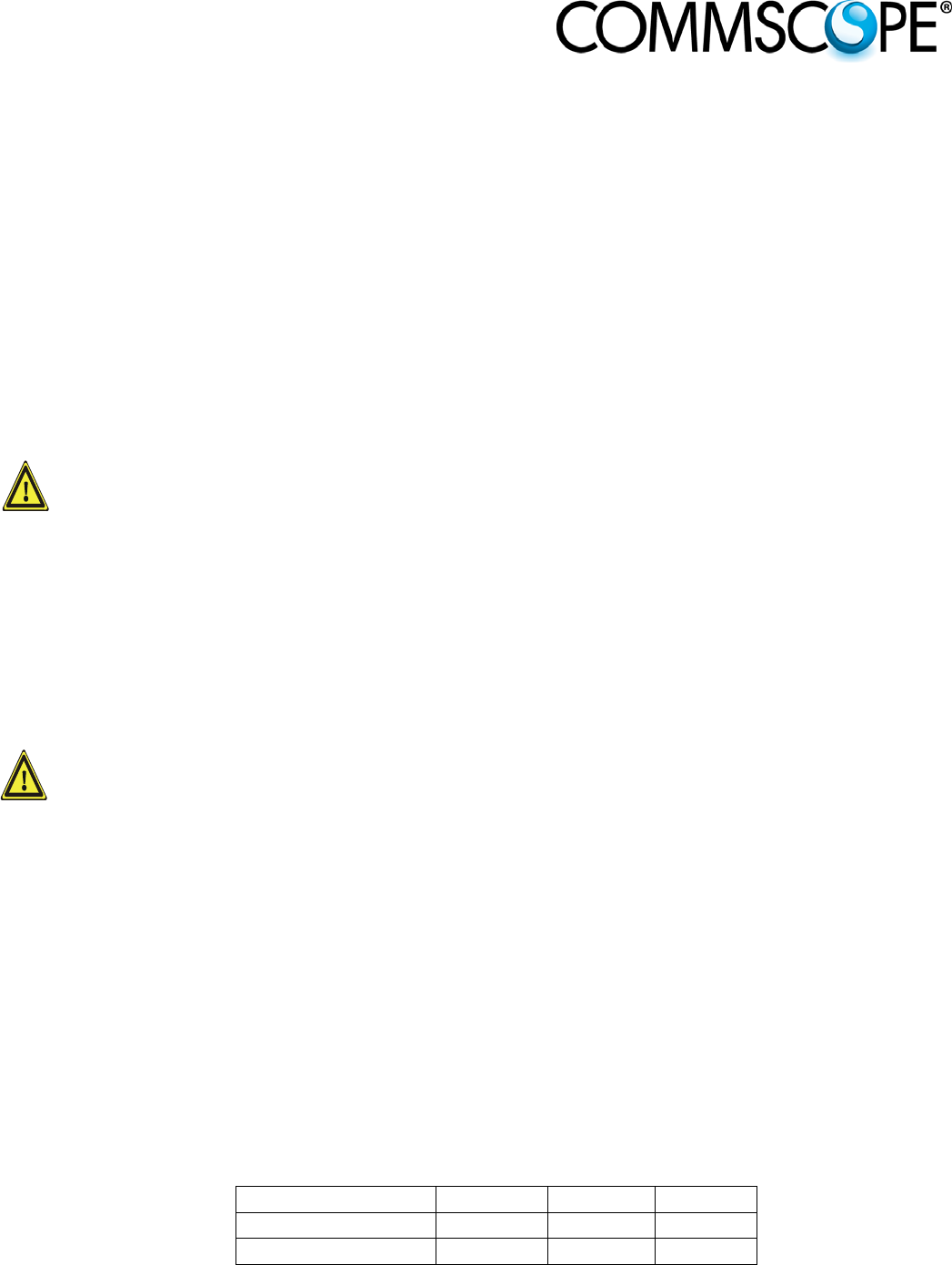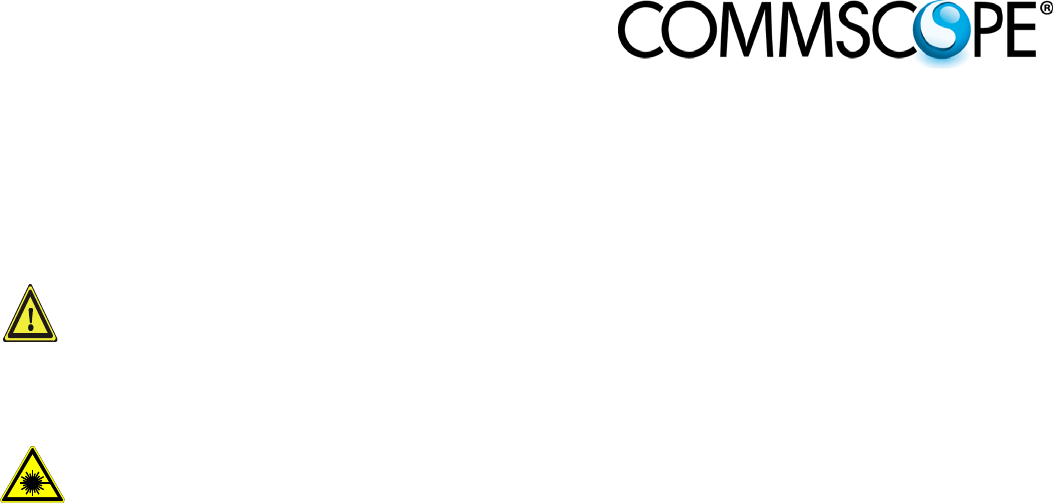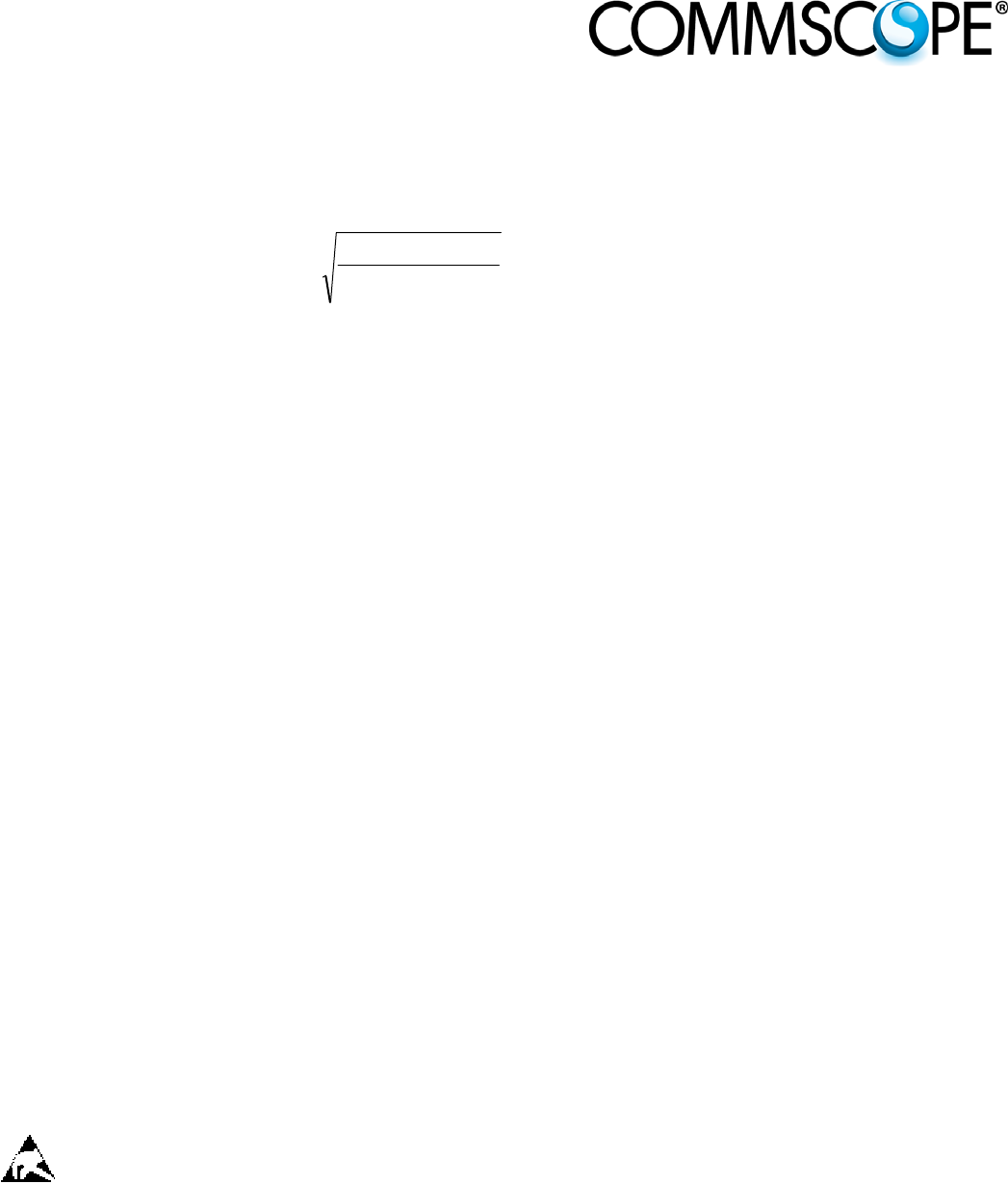Andrew Wireless System TFAHES7850 ION-B Remote Unit for cellular systems User Manual Installation Instruction
Andrew Wireless System ION-B Remote Unit for cellular systems Installation Instruction
Contents
- 1. user manual
- 2. installation instruction
installation instruction

Installation Instruction
The Remote Unit, Extension Unit or Master Unit has to be
mounted by proffessionel / special trained installer.
1.1. TFAX CASE U MECHANICAL INSTALLATION
1.1.1. General
Read the health and safety warnings in chapter 1.3.
1. Warning: Do not install the unit in a way or at a place where the specifications
outlined in the Environmental and Safety Specifications leaflet of the supplier are not
met.
2. WARNING: IMPROPER INSTALLATION CAN LEAD TO EQUIPMENT FALLING
CAUSING SERIOUS PERSONAL INJURY OR DAMAGE TO EQUIPMENT. The installer
must verify that the supporting surface will safely support the combined load of the
electronic equipment and all attached hardware and components. The screws and
dowels (wall anchors) used should also be appropriate for the structure of the
supporting wall.
3. Warning: It is recommended to use the mounting hardware delivered by the
manufacturer only. If different mounting hardware is used, the specifications for
stationary use of the Remote Unit must not be exceeded.
4. Note: Exceeding the specified load limits may cause the loss of warranty!
5. Warning: The unit is considerably heavy. Ensure there is adequate manpower to
handle the weight of the system.
6. Caution: Due to power dissipation, the Remote Unit may reach a very high
temperature. Ensure sufficient airflow for ventilation.
7. Note: When connecting and mounting the cables (RF, optical, mains, ...) ensure that
no water can penetrate into the unit through these cables.
8. Note: Observe all additional rules or restrictions regarding mounting that apply to
specific Remote Unit types.
If any different or additional mounting material is used, ensure that the mounting remains as safe as the
mounting designed by the manufacturer. Ensure that the static and dynamic strengths are adequate for
the environmental conditions of the site. The mounting itself must not vibrate, swing or move in any
way that might cause damage to the Remote Unit.
Specified torques must be observed for certain mounting procedures according to the following table:
Type Pins Hex nuts Screws
Thread M 6 M 6 M6
Specified torques 3.3 Nm 3.3 Nm 3.3 Nm

1.2. TFAX CASE U ELECTRICAL INSTALLATION
1.2.1. General
Read the health and safety warnings in chapter 1.3.
1. Warning: This unit contains dangerous voltages. Loss of life, severe personal injury, or
property damage can be the result if the instructions contained in this manual are not
followed.
2. Caution: It is compulsory to ground (earth) the unit before connecting the power supply. A
grounding bolt is provided on the cabinet to connect the ground-bonding cable.
3. Caution: Although the remote unit is internally protected against overvoltage, it is strongly
recommended to ground (earth) the antenna cables close to the antenna connectors of the
remote unit for protection against atmospheric discharge. In areas with strong lightning, it
is strongly recommended to install additional lightning protection.
4. Caution: If the mains connector of the remote unit is not easily accessible, a disconnect
device in the mains power circuit must be provided within easy reach.
5. Caution: Before connecting or disconnecting the mains connector at the remote unit,
ensure that mains power supply is disconnected.
6. Caution: Make sure that an appropriate circuit breaker acting as a disconnect device (as
required by IEC/EN60950-1) and an overcurrent limiting device are connected between
mains power and the Remote Unit.
7. Caution: A connection of the mains supply to a power socket requires the power socket to
be nearby the remote unit.
8. Caution: Incorrectly wired connections can destroy electrical and electronic components.
9. Caution: To avoid corrosion at the connectors caused by electrochemical processes, the
material of the cable connectors must not cause a higher potential difference than 0.6 V
(see electrochemical contact series).
10. Note: Use an appropriate torque wrench for the coupling torque of N-type connectors (2
Nm / 1.5 lb/ft), with 13/16 in opening to tighten the N-type antenna connectors. For
example, use torque wrench of item no. 244379 available from the CommScope e-catalog.
Do NOT use your hands or any other tool (e.g. a pair of pliers)! This might cause damage
to the connector and lead to a malfunction of the Remote Unit.
11. Caution: For unstabilized electric networks, which frequently generate spikes, the use of a
voltage limiting device is advised.
12. Caution: The unit complies with the surge requirement according to EN 61000-4-5 (fine
protection); however, installation of an additional medium (via local supply connection)
and/or coarse protection (external surge protection) is recommended depending on the
individual application in order to avoid damage caused by overcurrent.

13. Caution: Observe the labels on the front panels before connecting or disconnecting any
cables.
1.3. HEALTH AND SAFETY WARNINGS
1. Danger: Obey all general and regional installation and safety regulations relating to work on high
voltage installations, as well as regulations covering correct use of tools and personal protective
equipment.
2. Danger: Before opening the unit, disconnect mains power.
3. Danger: Laser radiation! Do not stare into the beam; do not view it directly or with optical
instruments.
4. Danger: Due to power dissipation, the remote unit may reach a very high temperature. Do not
operate this equipment on or close to flammable materials. Use caution when servicing the unit.
5. Warning: Read and obey all the warning labels attached to the unit. Make sure that all warning
labels are kept in a legible condition. Replace any missing or damaged labels.
6. Warning: It is the responsibility of the network provider to implement prevention measures to avoid
health hazards associated with radiation from the antenna(s) connected to the unit.
7. Warning: Only authorized and trained personnel are allowed to open the unit and get access to the
inside.
8. Warning: Only license holders for the respective frequency range are allowed to operate this unit.
9. Warning: Make sure the repeater settings are correct for the intended use (refer to the manufacturer
product information) and regulatory requirements are met.
10. Warning: Use this equipment only for the purpose specified by the manufacturer. Do not carry out
any modifications or fit any spare parts, which are not sold or recommended by the manufacturer.
This could cause fires, electric shock, or other injuries.
11. Warning: For installations which have to comply with European EN50385 exposure compliance
requirements, the following Power Density limits/guidelines (mW/cm²) according to ICNIRP are
valid:
o 0.2 for frequencies from 10 MHz to 400 MHz
o F (MHz) / 2000 for frequencies from 400 MHz to 2 GHz
o 1 for frequencies from 2 GHz to 300 GHz

12. Warning: For installations, which have to comply with FCC RF exposure requirements, the antenna
selection and installation must be completed in a way to ensure compliance with those FCC
requirements. Depending on the RF frequency, rated output power, antenna gain, and the loss
between the repeater and antenna, the minimum distance D to be maintained between the antenna
location and human beings is calculated according to this formula:
]/[
][
][
2
4cmmW
mW
cm PD
P
D
where
P (mW) is the radiated power at the antenna, i.e. the max. rated repeater output power in
addition to the antenna gain minus the loss between the repeater and the antenna.
PD (mW/cm²) is the allowed Power Density limit acc. to 47 CFR 1.1310 (B) for general
population / uncontrolled exposures which is
o F (MHz) / 1500 for frequencies from 300MHz to 1500MHz
o 1 for frequencies from 1500MHz to 100.000MHz
RF exposure compliance may need to be addressed at the time of licensing, as required by the
responsible FCC Bureau(s), including antenna co-location requirements of 1.1307(b)(3).
13. Caution: Installation of this equipment is in full responsibility of the installer, who has also the
responsibility, that cables and couplers are calculated into the maximum gain of the antennas, so that
this value, which is filed in the FCC Grant and can be requested from the FCC data base, is not
exceeded. The industrial boosters are shipped only as a naked booster without any installation
devices or antennas as it needs for professional installation.
14. Caution: Only suitably qualified personnel are allowed to work on this unit and only after becoming
familiar with all safety notices, installation, operation and maintenance procedures contained in this
manual.
15. Caution: Keep operating instructions within easy reach and make them available to all users.
16. Caution: Corresponding local particularities and regulations must be observed. For national
deviations, please refer to the respective documents included in the manual CD that is delivered with
the unit.
17. Caution: Although the remote unit is internally protected against overvoltage, it is strongly
recommended to ground (earth) the antenna cables close to the repeater’s antenna connectors for
protection against atmospheric discharge.
18. Caution: ESD precautions must be observed! Before commencing maintenance work, use the
available grounding (earthing) system to connect ESD protection measures.

19. Note: For a Class A digital device or peripheral:
This equipment has been tested and found to comply with the limits for a Class A digital device,
pursuant to part 15 of the FCC Rules. These limits are designed to provide reasonable protection
against harmful interference when the equipment is operated in a commercial environment. This
equipment generates, uses, and can radiate radio frequency energy and, if not installed and used in
accordance with the instruction manual, may cause harmful interference to radio communications.
Operation of this equipment in a residential area is likely to cause harmful interference in which case
the user will be required to correct the interference at his own expense.
20. Note: This unit complies with European standard EN60950.
Equipment Symbols Used
Please observe the meanings of the following symbols used in our equipment and the compliance
warnings:
Symbol Compliance Meaning
--- FCC
WARNING. This is NOT a CONSUMER device.
It is designed for installation by FCC LICENSEES
and QUALIFIED INSTALLERS. You MUST
have an FCC LICENSE or express consent of an
FCC Licensee to operate this device.
Unauthorized use may result in significant
forfeiture penalties, including penalties in excess
of $100,000 for each continuing violation.
CE
Alert sign to R&TTE
To be sold exclusively to mobile operators or
authorized installers – no harmonised frequency
bands, operation requires license
Intended use: EU and EFTA countries
Indicates conformity with the R&TTE directive
1999/5/EC certified by the notified body no. 0700.